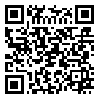Volume 79, Issue 1 (April 2021)
Tehran Univ Med J 2021, 79(1): 51-60 |
Back to browse issues page
Download citation:
BibTeX | RIS | EndNote | Medlars | ProCite | Reference Manager | RefWorks
Send citation to:



BibTeX | RIS | EndNote | Medlars | ProCite | Reference Manager | RefWorks
Send citation to:
Dehghani M, Niktabar S, Samei A, Mohammadi S. The effect of auditory sensory stimulation with familiar voice on recovery from anesthesia in patients undergoing rhinoplasty. Tehran Univ Med J 2021; 79 (1) :51-60
URL: http://tumj.tums.ac.ir/article-1-11138-en.html
URL: http://tumj.tums.ac.ir/article-1-11138-en.html
1- Department of Anesthesia, Shahid Sadoughi University of Medical Sciences, Yazd, Iran.
2- Department of Plastic Surgery, Shahid Sadoughi University of Medical Sciences, Yazd, Iran.
3- Operating Room Group ,Paramedicine Faculty, Shahid Sadoughi University of Medical Sciences, Yazd, Iran.
2- Department of Plastic Surgery, Shahid Sadoughi University of Medical Sciences, Yazd, Iran.
3- Operating Room Group ,Paramedicine Faculty, Shahid Sadoughi University of Medical Sciences, Yazd, Iran.
Abstract: (1725 Views)
Background: Anesthesia duration can play a significant role in post-operative complications. Therefore, the present study investigated the effect of auditory sensory stimulation with a familiar voice on anesthesia return in patients undergoing rhinoplasty.
Methods: This study was performed on 80 patients who were candidates for rhinoplasty surgery in Yazd Trauma and Burn Hospital from September-2018 to October-2019. The patients were randomly divided into two groups of 40: control and intervention. For patients in the control group, routine nursing care was performed after entering the recovery room. In addition to routine care, the patients in the intervention group were stimulated with a 15-minute pre-recorded audio. Patients' hemodynamic parameters were recorded before and after hearing stimulation. Also, the return time of the patient from anesthesia was recorded. Finally, the collected data were entered into SPSS software (Ver. 22) and analyzed using an independent sample t-test and Repeated mesasure ANOVA.
Methods: This study was performed on 80 patients who were candidates for rhinoplasty surgery in Yazd Trauma and Burn Hospital from September-2018 to October-2019. The patients were randomly divided into two groups of 40: control and intervention. For patients in the control group, routine nursing care was performed after entering the recovery room. In addition to routine care, the patients in the intervention group were stimulated with a 15-minute pre-recorded audio. Patients' hemodynamic parameters were recorded before and after hearing stimulation. Also, the return time of the patient from anesthesia was recorded. Finally, the collected data were entered into SPSS software (Ver. 22) and analyzed using an independent sample t-test and Repeated mesasure ANOVA.
|
Results: The results of this study showed that from the fifth minute after auditory sensory stimulation, the mean arterial pressure (MAP) in the intervention group was significantly higher than the control group (P<0.05). So that MAP in recovery (as the last follow-up) in the intervention group with a mean of 86.85±4.11 mmHg was significantly higher than the control group with a mean of 81.88±6.68 mmHg (P<0.001). Besides, the duration of recovery from anesthesia in the intervention group was significantly less than the control group (mean time: 24.05±3.39 min vs. 34.70±70.73 min; P<0.001). Finally, nausea was observed in only 7.5% of patients in the control group and agitation was reported in 5% of the control group and 5% of the intervention group (P>0.05).
Conclusion: According to the results, the use of auditory sensory stimuli with a familiar voice can significantly decrease the duration of recovery from anesthesia. Also, it plays a crucial role in changing the SBP, DBP, and MAP of these patients to normal levels. |
Type of Study: Original Article |
| Rights and permissions | |
 |
This work is licensed under a Creative Commons Attribution-NonCommercial 4.0 International License. |





